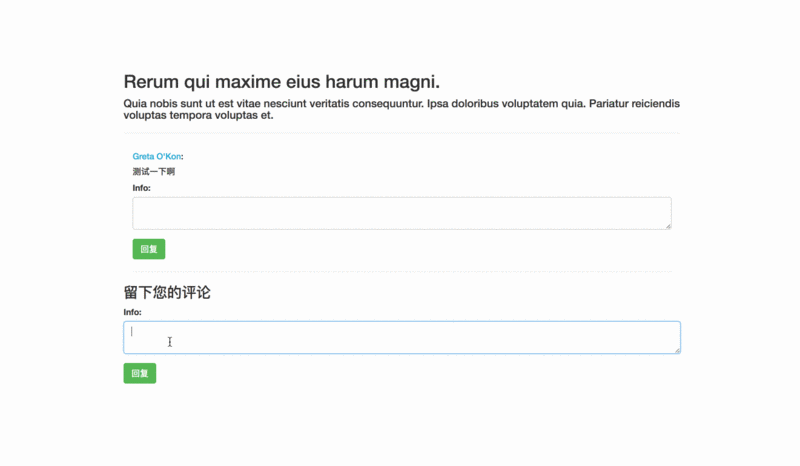Laravel5はネストされたコメントの形式を実装します(詳細なコードの説明)
この記事の内容は、Laravel5 で実装されているネストされたコメントの形式に関するものです (詳細なコードの説明)。必要な方は参考にしていただければ幸いです。
コメントがさまざまな形式で表示されるのをよく見かけます。たとえば、「@」なんとかなど、Zhihu のような縮小コメント、ネストされたコメントなどです。そのため、最初は次のようになります。最も一般的なのは次のとおりです。
#準備作業
Schema::create('users', function (Blueprint $table) {
$table->increments('id');
$table->string('name');
$table->string('email')->unique();
$table->string('password');
$table->rememberToken();
$table->timestamps();
});Schema::create('posts', function (Blueprint $table) {
$table->increments('id');
$table->string('title');
$table->integer('user_id')->index();
$table->text('content');
$table->timestamps();
});Schema::create('comments', function (Blueprint $table) {
$table->increments('id');
$table->integer('user_id')->index();
$table->integer('post_id')->index();
$table->integer('parent_id')->index()->default(0);
$table->text('body');
$table->timestamps();
});Post.php ファイル
/**
* 一篇文章有多个评论
* @return \Illuminate\Database\Eloquent\Relations\HasMany
*/
public function comments()
{
return $this->hasMany(Comment::class);
}
/**
* 获取这篇文章的评论以parent_id来分组
* @return static
*/
public function getComments()
{
return $this->comments()->with('owner')->get()->groupBy('parent_id');
}/**
* 这个评论的所属用户
* @return \Illuminate\Database\Eloquent\Relations\BelongsTo
*/
public function owner()
{
return $this->belongsTo(User::class, 'user_id');
}
/**
* 这个评论的子评论
* @return \Illuminate\Database\Eloquent\Relations\HasMany
*/
public function replies()
{
return $this->hasMany(Comment::class, 'parent_id');
}ロジックの記述実際に実装したいネストされたコメントには、準備作業でいくつかのアイデアがあり、最初に記事を表示します。すべてのコメントを表示するには、記事とコメントの間の 1 対多の関係を使用します。ただし、このフィールドは、実際には、グループ化を実行するために使用されます。 >comments()->with('owner')->get()->groupBy('parent_id') の具体的なプロセスは次のとおりです:
\Auth::loginUsingId(1); //用户id为1的登录
//显示文章和相应的评论
Route::get('/post/show/{post}', function (\App\Post $post) {
$post->load('comments.owner');
$comments = $post->getComments();
$comments['root'] = $comments[''];
unset($comments['']);
return view('posts.show', compact('post', 'comments'));
});
//用户进行评论
Route::post('post/{post}/comments', function (\App\Post $post) {
$post->comments()->create([
'body' => request('body'),
'user_id' => \Auth::id(),
'parent_id' => request('parent_id', null),
]);
return back();
});コードを表示ユーザーがお互いにコメントすることが増えるにつれて、ネストのレベルが増えるため、さまざまな方法を使用する必要があります。ここでコメント全体を表示するためのトリックです。 @include() 関数を使用して表示します。この試みの構造は次のとおりです。
- comments comments.blade.php form.blade.php list.blade.php - posts show.blade.php
nbsp;html>
<meta>
<meta>
<meta>
<link>
<div>
<div>
<h2 id="post-gt-title">{{$post->title}}</h2>
<h4 id="post-gt-content">{{$post->content}}</h4>
<hr>
@include('comments.list',['collections'=>$comments['root']])
<h3 id="留下您的评论">留下您的评论</h3>
@include('comments.form',['parentId'=>$post->id])
</div>
</div>
comment.blade.php
<div>
<h5>
<span>{{$comment->owner->name}}</span>:</h5>
<h5 id="comment-gt-body">{{$comment->body}}</h5>
@include('comments.form',['parentId'=>$comment->id])
@if(isset($comments[$comment->id]))
@include('comments.list',['collections'=>$comments[$comment->id]])
@endif
<hr>
</div>form.blade.php
list.blade.php
@foreach($collections as $comment)
@include('comments.comment',['comment'=>$comment])
@endforeach最終的なレンダリングは次のとおりです。

以上がLaravel5はネストされたコメントの形式を実装します(詳細なコードの説明)の詳細内容です。詳細については、PHP 中国語 Web サイトの他の関連記事を参照してください。

ホットAIツール

Undresser.AI Undress
リアルなヌード写真を作成する AI 搭載アプリ

AI Clothes Remover
写真から衣服を削除するオンライン AI ツール。

Undress AI Tool
脱衣画像を無料で

Clothoff.io
AI衣類リムーバー

AI Hentai Generator
AIヘンタイを無料で生成します。

人気の記事

ホットツール

メモ帳++7.3.1
使いやすく無料のコードエディター

SublimeText3 中国語版
中国語版、とても使いやすい

ゼンドスタジオ 13.0.1
強力な PHP 統合開発環境

ドリームウィーバー CS6
ビジュアル Web 開発ツール

SublimeText3 Mac版
神レベルのコード編集ソフト(SublimeText3)

ホットトピック
 7554
7554
 15
15
 1382
1382
 52
52
 83
83
 11
11
 28
28
 96
96
 クロスサイトリクエストフォーファリー(CSRF)とは何ですか?また、PHPにCSRF保護をどのように実装しますか?
Apr 07, 2025 am 12:02 AM
クロスサイトリクエストフォーファリー(CSRF)とは何ですか?また、PHPにCSRF保護をどのように実装しますか?
Apr 07, 2025 am 12:02 AM
PHPでは、予測不可能なトークンを使用して、CSRF攻撃を効果的に防ぐことができます。特定の方法には次のものが含まれます。1。フォームのCSRFトークンを生成および埋め込みます。 2.リクエストを処理するときにトークンの有効性を確認します。
 PHPで厳密なタイプ(declare(strict_types = 1);)を説明します。
Apr 07, 2025 am 12:05 AM
PHPで厳密なタイプ(declare(strict_types = 1);)を説明します。
Apr 07, 2025 am 12:05 AM
PHPの厳格なタイプは、declare(strict_types = 1)を追加することで有効になります。ファイルの上部に。 1)関数パラメーターのタイプチェックと戻り値を強制して、暗黙の型変換を防ぎます。 2)厳格なタイプを使用すると、コードの信頼性と予測可能性を改善し、バグを減らし、保守性と読みやすさを向上させることができます。
 どのようにしてクラスが拡張されたり、PHPでメソッドがオーバーライドされたりするのを防ぐことができますか? (最終キーワード)
Apr 08, 2025 am 12:03 AM
どのようにしてクラスが拡張されたり、PHPでメソッドがオーバーライドされたりするのを防ぐことができますか? (最終キーワード)
Apr 08, 2025 am 12:03 AM
PHPでは、最終的なキーワードを使用して、クラスが継承されないようにし、メソッドが上書きされます。 1)クラスを決勝としてマークする場合、クラスを継承することはできません。 2)メソッドを最終的にマークする場合、メソッドはサブクラスによって書き換えられません。最終的なキーワードを使用すると、コードの安定性とセキュリティが保証されます。
 PHPの未来:適応と革新
Apr 11, 2025 am 12:01 AM
PHPの未来:適応と革新
Apr 11, 2025 am 12:01 AM
PHPの将来は、新しいテクノロジーの傾向に適応し、革新的な機能を導入することで達成されます。1)クラウドコンピューティング、コンテナ化、マイクロサービスアーキテクチャに適応し、DockerとKubernetesをサポートします。 2)パフォーマンスとデータ処理の効率を改善するために、JITコンパイラと列挙タイプを導入します。 3)パフォーマンスを継続的に最適化し、ベストプラクティスを促進します。
 バングラ部分モデル検索のlaravelEloquent orm)
Apr 08, 2025 pm 02:06 PM
バングラ部分モデル検索のlaravelEloquent orm)
Apr 08, 2025 pm 02:06 PM
LaravelEloquentモデルの検索:データベースデータを簡単に取得するEloquentormは、データベースを操作するための簡潔で理解しやすい方法を提供します。この記事では、さまざまな雄弁なモデル検索手法を詳細に紹介して、データベースからのデータを効率的に取得するのに役立ちます。 1.すべてのレコードを取得します。 ALL()メソッドを使用して、データベーステーブルですべてのレコードを取得します:useapp \ models \ post; $ post = post :: all();これにより、コレクションが返されます。 Foreach Loopまたはその他の収集方法を使用してデータにアクセスできます。
 Laravelの地理空間:インタラクティブマップと大量のデータの最適化
Apr 08, 2025 pm 12:24 PM
Laravelの地理空間:インタラクティブマップと大量のデータの最適化
Apr 08, 2025 pm 12:24 PM
700万のレコードを効率的に処理し、地理空間技術を使用したインタラクティブマップを作成します。この記事では、LaravelとMySQLを使用して700万を超えるレコードを効率的に処理し、それらをインタラクティブなマップの視覚化に変換する方法について説明します。最初の課題プロジェクトの要件:MySQLデータベースに700万のレコードを使用して貴重な洞察を抽出します。多くの人は最初に言語をプログラミングすることを検討しますが、データベース自体を無視します。ニーズを満たすことができますか?データ移行または構造調整は必要ですか? MySQLはこのような大きなデータ負荷に耐えることができますか?予備分析:キーフィルターとプロパティを特定する必要があります。分析後、ソリューションに関連している属性はわずかであることがわかりました。フィルターの実現可能性を確認し、検索を最適化するためにいくつかの制限を設定しました。都市に基づくマップ検索
 PHP対Python:違いを理解します
Apr 11, 2025 am 12:15 AM
PHP対Python:違いを理解します
Apr 11, 2025 am 12:15 AM
PHP and Python each have their own advantages, and the choice should be based on project requirements. 1.PHPは、シンプルな構文と高い実行効率を備えたWeb開発に適しています。 2。Pythonは、簡潔な構文とリッチライブラリを備えたデータサイエンスと機械学習に適しています。
 PHPの現在のステータス:Web開発動向を見てください
Apr 13, 2025 am 12:20 AM
PHPの現在のステータス:Web開発動向を見てください
Apr 13, 2025 am 12:20 AM
PHPは、現代のWeb開発、特にコンテンツ管理とeコマースプラットフォームで依然として重要です。 1)PHPには、LaravelやSymfonyなどの豊富なエコシステムと強力なフレームワークサポートがあります。 2)パフォーマンスの最適化は、Opcacheとnginxを通じて達成できます。 3)PHP8.0は、パフォーマンスを改善するためにJITコンパイラを導入します。 4)クラウドネイティブアプリケーションは、DockerおよびKubernetesを介して展開され、柔軟性とスケーラビリティを向上させます。




